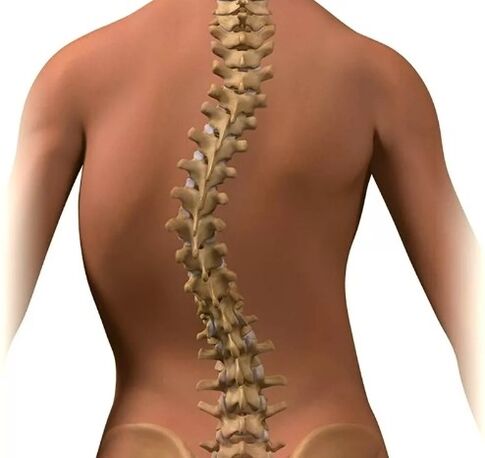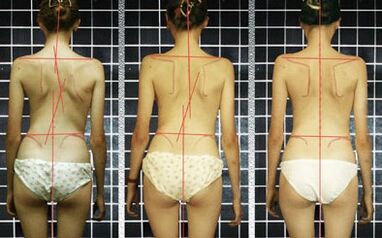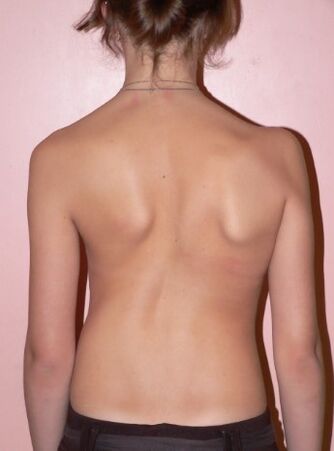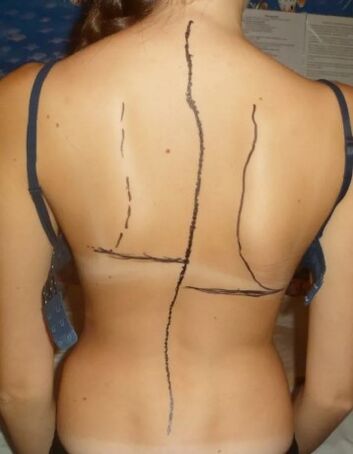In Greek there is the word "scolios" that looks "curved".In this word, doctors indicate the curvature of the spine.In fact, not all curvature, namely the lateral difference in the vertical axis of the spine.The thing is that our spine is usually not perfect.The bends available in the front and back (Lordoses and Kyphosis) protect our spine from excessive loads while keeping the body in a certain position when they move and carry.Negative processes in our bodies develop only in cases where these kyphoses and lordos are exceeded by allowed standards.

The main problems
At the same time, the spine side bends (skoliosis) are also small (skoliosis) is always a pathology.And the point is not just a cosmetic error.Although the characteristic repulsive appearance of pronounced or progressive skoliosis is always a tragedy for a person who wants to live a high -quality full life.This is especially true for young boys and girls.In fact, a significant part of skoliosis is diagnosed during the child and youth period (up to 15-16 years).
The main problem is that due to the changes in the chest configuration and volume, the side curvature, the internal organs always suffer (heart, lungs, stomach, liver, intestines, large blood vessels).In men, tolerance to physical effort is reduced, and women have problems with conception, pregnancy and having children.In fact, the side deformation of the spine is very often the surface of the iceberg, which is a much more severe pathology - tumor, tuberculosis, endocrine disorders.
Reasons
Then why does the spine deform?Before you answer the question, you need to decide on the type of skoliosis.Skoliosis can be structural and non -structural.Structural skoliosis is due to anatomical changes in the structural bone tissue and the structure of muscles, nerves and ligament devices.Such curves can be obtained and congenital, and about a quarter of all diagnosed skoliosis for the latter.
It is distinguished among the main causes of structural skoliosis:

- The masts of intrauterine development lead to one or more vertebrae to dysplastic disorders
- Congenital chest development disorders - lack of ribs, complementary ribs
- Congenital pathology of connective tissue - neurofibromatosis, Marfan syndrome
- Brain failure for children's brain paralysis (brain paralysis) leading to violation of some parts of the spine
- Spine osteoporosis (bone -pink) in ricks, diseases of the parathyroid glands, lack of calcium consumption for food
- The osteomyelitis of the vertebrae
- Distrophic changes in the cervix, chest and lumbar muscles
- Damage to tuberculosis of the vertebrae
- Spine injuries
- Tumor of the spine.
Non -structural skoliosis, from the name as follows, is the lateral differences in the shaft of the spinal column with the unchanged structure of the vertebrae.As a general rule, such skoliosis is most often obtained, except for cases where the curvature is compensated by the congenital anatomical errors of the pelvis or lower limbs.The causes of such skoliosis are most often:
- Pelvic injuries and lower limbs
- Congenital errors of pelvis and lower limbs
- Constant inappropriate posture in school children
- Diseases of internal organs with asymmetrically expressed pain syndrome
- Muscle inflammation (myositic)
- Burnings, scars on one side of soft tissues.
In these cases, it is sufficient to cure the underlying disease to eliminate the curvature of the spine, so many non -structural skoliosis is easily reversed.In this regard, some doctors generally do not report non -structural deformations of skoliosis.

Recently, cases of developing skoliosis with unclear causes have become more frequent.This is the so -called idiopathic skoliosis.This occurs in the youth years, during the rapid growth of the body.In fact, girls suffer more often in idiopathic skoliosis than young men.Obviously, this is due to the relatively weak muscles of the woman's back, which is unable to locate the spine into a whole muscle frame.A balanced diet with low calcium salts and the passion for youth with carbonated drinks does not play the last role in the development of idiopathic scholosis.As you know, in bubbles and orthophosphoric acid, carbon dioxide in synthetic inclusions contributes to the leaching of calcium salts from the body.
Varieties and degrees
Depending on the localization, skoliosis can be cervical, chest, lumbar or mixed (cervix, lumbosac).It is possible for one or more curved arcs.In this regard, C-shaped skoliosis (1 curved), S-shaped (2 arc) and Z-shaped (3 arc) can be distinguished.Probably the presence of 2 or 3 arches is compensating.In the case of C -shaped skoliosis, the shaft of the spinal column is different.To compensate for this, the spine is leaning in the opposite direction.In this respect, skoliosis is compensated and uncompenated.In the curvature of the compensated spine, the vertical line, which is lowered from the spine of the cervix, passes through the drive between the bottom.
The curvature of the spine is often combined.For example, in the chest region, with the side curvature, abnormal kyphosis or simply humped.In these cases, speaking of chest kyphoscoliosis.In addition, with a high degree of skoliosis, we also observe Thuria in addition to the lateral displacement of the vertebrae.In a literal translation, this means they are twisted.In fact, with many skoliosis, the spinal tissue is screwed along the vertical axis.
Depending on the size of the curvature curvature 4 Skoliosis can be distinguished:
- 1 grade- The angle of curvature does not exceed 10 degrees.Asymmetry is virtually impossible to determine.Stoop, the unequal level of the shoulder belt, is watching.
- 2 degrees- The curvature angle is 11-25 degrees.In this sense, the vertebrae have already been remembered.There is an asymmetry in the shoulder belt and the pool that is visible in the eyes.Due to the abnormal muscle tension, muscle cylinder is formed in the lumbar region from the concave side and convex in the chest area.
- 3 degrees- Wrtification is 26-50 degrees.Visible deformation of the chest - the western part of intercostal spaces on the curvature concave side and swelling with convex.Weakening of the abdominal press, the formation of the inner hump.
- 4 degrees- The angle of curvature I exceeds 50 degrees.Cosmetic error and all previous signs are expressed.Low tolerability of small physical effort.Outside the muscle bone system, the internal organs suffer.

The angle may vary depending on the position of the body, while stable and unstable skoliosis can be distinguished.In the case of unstable skoliosis, the lying position is reduced when the load on the spinal column is reduced.With stable curvature of the spine, this value remains unchanged.
Symptoms
Recently, orthopedics often use the term "skoliotic disease".And indicate the complex of negative changes that occur in the body during the curvature of the spine.As a general rule, Skoliotic disease develops during childhood and adolescence during the formation of muscle bone system.At this time, there is a high probability that skoliosis progresses.
Obviously, intervertebral discs play an important role in increasing the curvature angle.With the side displacement, the disc puts unequal pressure from the spinal bodies.On the concave side, this pressure is higher with convex - less.As a result, the disc is even more worn out due to skoliosis, with pathological muscle tension (muscle cylinder) and vertebrae - leading to the appearance of the disc and further growth of curvature.

Next to the spine with skoliotic disease, the chest changes second.The so -called rib hump is formed - on the convex side of the curvature, the intercostal spaces are expanded, and on the contrary, they are deployed.In addition to degrees 4 degrees, the deformation of the chest can be pronounced so much that the lower ribs on the side of the curvature are in contact with the rowing of the joint bone.
Due to the severe deformation of the chest, full -time excursion is difficult during breathing.As a result, the body with severe scholosis does not receive the required amount of oxygen - chronic hypoxia called SO develops by violation of all the metabolic processes of the body.The pathology is exacerbated by the fact that the interior volume and shape of the chest cavity change.As a result, blood circulation of blood vessels is disturbed, the lungs suffer, the shape of the heart changes, and a chronic cardiovascular failure develops.
Similar changes occur in the abdominal organs for lumbar and lumbosacral skoliosis.The motorcycle of the stomach and intestines decreased with the later enzymatic insufficiency of the digestive glands.All this exacerbates the metabolic disorders.These violations often result in sexual maturation of boys and girls.In addition, due to lumbar skoliosis, the pelvis is curved for the second time.This causes problems for future mothers with pregnancy and having children.
Diagnosis
Skoliosis, especially diagnosing large degrees, is usually not difficult.Common visual examination is often enough to detect spinal deformation.The curvature of the spine's contours, the asymmetry of the shoulders, the nails of the blades, the secondary curvature of the pelvis and the lower limb on the curvature.
In the presence of at least one of these signs, the radiography of the spinal column is indicated.X -Ray determines the configuration, degree and localization of curvature.During the control and radiological examination, it can be determined that Skoliosis is compensated and stable.Recently, a qualitative new method of spinal magnetic resonance imaging (MRI) has been widespread, whereby the three-dimensional image of the spine is available on the monitor screen.Significant curvature of the internal organs should be examined - to perform spiritetry, electrocardiography, and ultrasound of the heart and internal organs.
Treatment
Treatment of skoliosis can be done both conservative and immediately.Conservative methods include drug treatment, massage, physiotherapy procedures and manual therapy.Keep in mind that the final formation of the spine ends up to the age of 20, and after this age the curvature correction is almost impossible.For 1-2 degrees Skoliosis, the purpose of the effort is to achieve the initial, normal configuration of the spine.In the case of a pronounced scholosis of 3 - 4, this is unavailable, the most important here is the stabilization of the spine and preventing the progress of skoliosis.

Medicines (chondroprotectors, vitamins, general strengthening drugs) play an complementary role in the treatment of skoliosis.To strengthen the muscles, remove the muscle roller and even stabilize the spine with massage and manual therapy.Physiotherapy exercises have a good effect.But here, with inadequate physical effort, the instability of the spine increases and the skoliosis progresses.Therefore, individual patients are developed separately, taking into account the localization and severity of the curvature.High degrees of Skoliosis, running, power exercises, jumps, outdoor games are contraindicated.
A very good result results in correction in the situation - an optimal pose is created, which contributes to normalization of posture.For this, special tools are used, orthopedic cribs, in which young patients spend a lot of time.The efficiency of conservative measures, the progress of the curvature, and the surgical treatment for stabilization of the spine are indicated.The surgical correction is not shown in early childhood, when the spine is almost completed.

















































